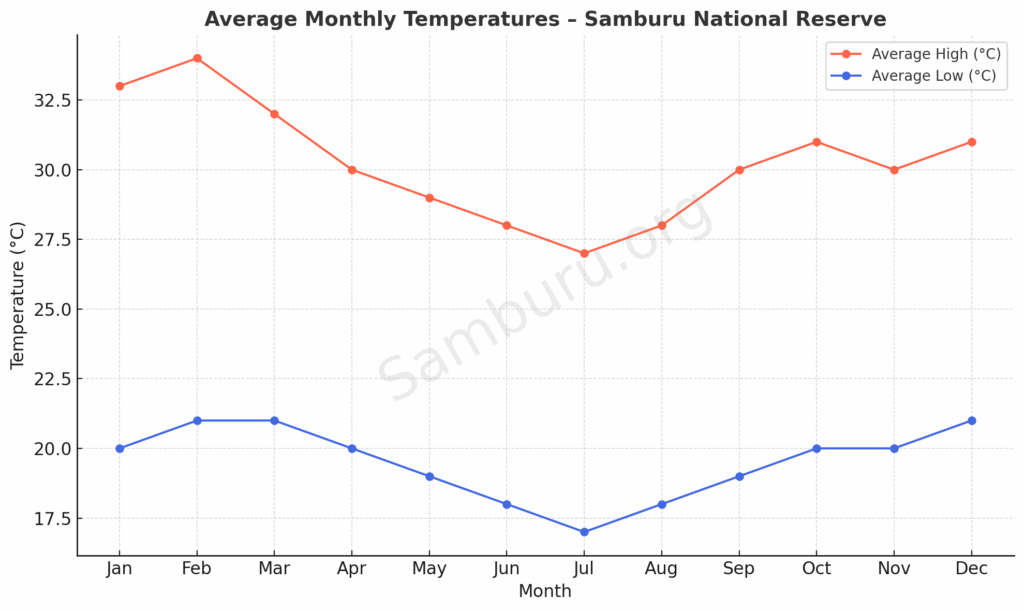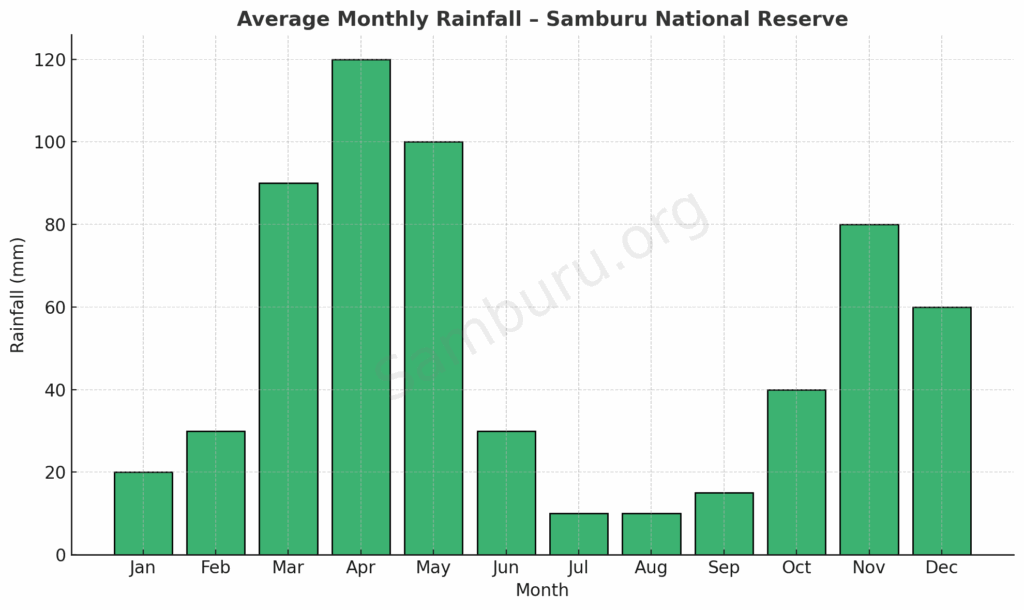Understanding Northern Kenya’s Dryland Seasons and How to Prepare for Your Safari
🌍 Overview: The Climate of Samburu National Reserve
Samburu National Reserve lies in northern Kenya, within Samburu County, about 320 km north of Nairobi.
The reserve sits at an elevation of 850–1,250 meters (2,800–4,100 feet) above sea level, making its climate hot, dry, and semi-arid for most of the year.
Despite being part of Kenya’s equatorial zone, Samburu’s proximity to the equator combines with its low altitude and dry terrain to create distinctive day-night temperature contrasts, low humidity, and dramatic seasonal variations in rainfall and vegetation.
Samburu’s weather is among the most predictable and safari-friendly in Kenya — warm days, cool mornings and evenings, and sunshine almost year-round.
🌡️ General Climate Profile
| Climate Type | Semi-arid tropical (hot, dry, and sunny most of the year) |
|---|---|
| Average Altitude | 1,000 meters above sea level |
| Average Annual Rainfall | 350–500 mm (13–20 inches) |
| Average Temperatures | 20°C – 35°C (68°F – 95°F) |
| Humidity | Low (20%–40%) |
| Sunshine Hours per Day | 8–10 hours |
| Rainy Seasons | March–May (long rains) and November–December (short rains) |
| Dry Seasons | January–February and June–October |
☀️ Seasons in Samburu National Reserve
Samburu’s climate follows four main seasonal patterns that shape its landscapes, wildlife behavior, and visitor experience.
1. Long Dry Season (June – October)
Best Time for Game Viewing
- Average Temperature: 28°C–32°C (82°F–90°F) daytime; 16°C–20°C (61°F–68°F) at night
- Rainfall: Minimal to none
- Humidity: Low
- Landscape: Golden, dry savannah with sparse vegetation
- Wildlife: Animals congregate along the Ewaso Nyiro River and permanent waterholes.
- Sky Conditions: Clear skies and bright sunlight ideal for photography.
- Travel Conditions: Roads are dry and accessible; dust levels increase in the afternoons.
✅ Why Visit:
- Peak season for sightings of the Samburu Special Five and large herds of elephants.
- Little rainfall means easy animal tracking and open visibility.
- Cool mornings and evenings — perfect for game drives.
🧳 What to Pack:
- Light cotton clothing, a hat, sunglasses, and sunscreen.
- A warm layer or fleece for chilly dawns and nights.
2. Short Rains (November – December)
The Green Season Begins
- Average Temperature: 25°C–30°C (77°F–86°F)
- Rainfall: Short, scattered showers, often in the afternoon or evening.
- Landscape: Vegetation greens up quickly; wildflowers appear.
- Wildlife: Abundant food brings young animals; birds begin nesting.
- Sky Conditions: Mix of sunshine and dramatic clouds — stunning light for photography.
✅ Why Visit:
- Fewer tourists, lower lodge rates, and more vibrant scenery.
- Excellent for birdwatching, with migrant species arriving from Europe and Asia.
- Rains rarely disrupt game drives — showers are brief and refreshing.
🧳 What to Pack:
- A light rain jacket or poncho.
- Waterproof covers for cameras and bags.
- Neutral-colored clothes that dry quickly.
3. Long Rains (March – May)
The Wet and Lush Season
- Average Temperature: 26°C–32°C (79°F–90°F)
- Rainfall: 150–250 mm (frequent afternoon or nighttime thunderstorms).
- Landscape: Verdant and scenic; rivers swell and seasonal luggas (dry channels) fill briefly.
- Wildlife: Animals are widely dispersed due to abundant water and grass.
- Sky Conditions: Cloudy intervals, dramatic sunsets, and lush greenery.
✅ Why Visit:
- Exceptional photography, especially after storms when the light softens.
- Fewer vehicles and a more peaceful safari experience.
- Excellent for botanical and bird enthusiasts — over 450 bird species recorded.
⚠️ Things to Note:
- Some roads may become slippery or temporarily impassable after heavy rain.
- 4×4 vehicles (Land Cruisers) are recommended.
🧳 What to Pack:
- Waterproof shoes and rain protection.
- Extra insect repellent (mosquitoes are slightly more active).
4. Short Dry Season (January – February)
Hot, Clear, and Excellent for Wildlife
- Average Temperature: 30°C–35°C (86°F–95°F) daytime; 18°C–22°C (64°F–72°F) at night
- Rainfall: Almost none
- Landscape: Dry and dusty; sparse vegetation enhances visibility.
- Wildlife: High concentration near permanent water sources.
- Sky Conditions: Bright, cloudless skies; intense midday sun.
✅ Why Visit:
- Perfect for photography with unobstructed views.
- Excellent visibility for big cats and elephants.
- Reliable weather with minimal risk of showers.
🧳 What to Pack:
- Breathable clothing and a refillable water bottle.
- Moisturizer and lip balm (air is very dry).
📆 Monthly Weather Averages in Samburu National Reserve

| Month | Avg. High (°C) | Avg. Low (°C) | Rainfall (mm) | Weather Notes |
|---|---|---|---|---|
| January | 33 | 20 | 20 | Hot and dry; ideal for safaris |
| February | 34 | 21 | 30 | Very dry; great for photography |
| March | 32 | 21 | 90 | Beginning of long rains |
| April | 30 | 20 | 120 | Peak of long rains; lush vegetation |
| May | 29 | 19 | 100 | Gradual drying; roads still muddy |
| June | 28 | 18 | 30 | Dry season begins; clear skies |
| July | 27 | 17 | 10 | Cool mornings, hot afternoons |
| August | 28 | 18 | 10 | Dry and ideal for game viewing |
| September | 30 | 19 | 15 | Warm and dry; wildlife concentrated |
| October | 31 | 20 | 40 | End of dry season; pre-rain humidity |
| November | 30 | 20 | 80 | Short rains start; green season returns |
| December | 31 | 21 | 60 | Green, fresh landscapes, and bird migration |
(Values are approximate based on long-term climate data from Samburu County and Kenya Meteorological Department.)

🌳 How Weather Shapes the Samburu Landscape
Samburu’s semi-arid climate is part of what makes it so visually striking.
- During the dry season, the landscape turns golden and dusty — an ethereal backdrop for giraffes, elephants, and oryxes.
- When rains arrive, the plains burst into green life within days — the acacias bloom, wildflowers carpet the ground, and birds fill the skies.
- Seasonal “luggas” (dry riverbeds) channel stormwater briefly and then dry out, leaving fresh grazing areas for wildlife.
- The Ewaso Nyiro River, the only permanent watercourse, ensures year-round wildlife even during prolonged dry spells.
🦓 Impact of Seasons on Wildlife Behavior
| Season | Wildlife Highlights | Visitor Experience |
|---|---|---|
| Dry Season (Jun–Oct, Jan–Feb) | High concentration of animals along the Ewaso Nyiro River and waterholes; frequent elephant and big cat sightings. | Best overall safari experience. Excellent visibility. |
| Short Rains (Nov–Dec) | Calving season for antelopes; birds nesting and displaying plumage. | Vibrant greenery and colorful skies. |
| Long Rains (Mar–May) | Widespread dispersal of herbivores; fewer predators spotted. | Peaceful atmosphere, lush photography, low tourist numbers. |
🧳 What to Pack for the Samburu Climate
| Category | Recommendations |
|---|---|
| Clothing | Light cotton shirts, trousers, and breathable layers. Neutral safari colors (khaki, beige, olive). |
| Warm Layers | Fleece or jacket for early morning game drives. |
| Rain Protection | Light raincoat or poncho (Nov–May). |
| Footwear | Closed walking shoes or light boots. |
| Accessories | Hat, sunglasses, sunscreen, and lip balm. |
| Health | Insect repellent and rehydration salts. |
| Photography Gear | Lens cloth (for dust), UV filter, camera rain cover. |
🌅 Best Time to Visit Samburu (Summary)
| Purpose | Best Months | Why |
|---|---|---|
| Game Viewing | June – October, January – February | Dry weather concentrates wildlife along the river. |
| Photography | November – December | Lush green backdrops and soft light. |
| Birdwatching | November – April | Migratory species arrive; nesting season. |
| Peaceful Safari | March – May | Fewer tourists, serene atmosphere. |
🌄 Weather and Accessibility Tips
- The main access roads (A2 Highway, Archer’s Post) are all-weather, but internal tracks can get muddy during April–May.
- 4×4 vehicles (Land Cruiser or similar) are recommended during rainy months.
- Most lodges and camps remain open year-round and are well-prepared for seasonal changes.
- Always carry extra drinking water — temperatures can rise sharply at midday.
- Electricity and solar power at camps may fluctuate during long rains; pack a power bank.
🌍 Regional Climate Context: Northern Kenya Drylands
Samburu’s climate is part of the Northern Kenya Arid and Semi-Arid Lands (ASALs), which include neighboring regions like:
- Buffalo Springs and Shaba Reserves (similar patterns)
- Isiolo, Marsabit, and Laikipia (slightly cooler)
- Reteti Elephant Sanctuary and Namunyak Conservancy (higher altitude, more rainfall)
These interconnected ecosystems share the same Ewaso Nyiro basin, where seasonal water availability dictates wildlife movement and vegetation cycles.
☀️ In Summary
Samburu National Reserve enjoys one of Kenya’s most stable and safari-friendly climates.
Its warm, sunny days, clear skies, and dramatic seasonal contrasts create the ideal environment for photography, wildlife encounters, and exploration.
Unlike coastal or highland destinations, Samburu remains accessible and enjoyable year-round — a true testament to Kenya’s diverse climatic zones.